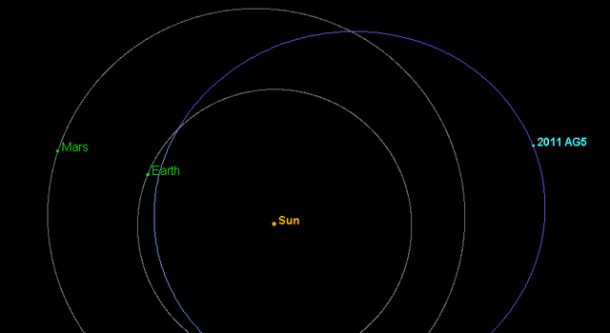
Talk about the asteroid was on the agenda during the 49th session of the Scientific and Technical Subcommittee of the United Nations Committee on the Peaceful Uses of Outer Space (COPUOS), held earlier in Vienna.
Due to its current location in the daytime sky, observations of 2011 AG5 cannot be made by Earth-based telescopes, so its orbit has not yet been determined to a level where scientists can confidently project its location decades into the future. But that day is coming.
"In September 2013, we have the opportunity to make additional observations of 2011 AG5 when it comes within 91 million miles (147 million kilometers) of Earth," said Don Yeomans, manager of NASA's Near-Earth Object Program Office at the Jet Propulsion Laboratory in Pasadena, California.
"It will be an opportunity to observe this space rock and further refine its orbit. Because of the extreme rarity of an impact by a near-Earth asteroid of this size, I fully expect we will be able to significantly reduce or rule out entirely any impact probability for the foreseeable future." Even better observations will be possible in late 2015.
To be a real danger to Earth and have a strike probability of 1 in 625, the asteroid has to fly through a particular keyhole-like area of space in September 2013. Schweickart said a decision to deflect 2011 AG 5 away from this keyhole, by changing its path using gravitational effects, should be made "very soon, if not now".
"If a keyhole deflection is ruled out as option, a direct deflection is marginally possible, at best," he said, adding that directly deflecting the asteroid would be difficult with existing launch vehicle capability.
2011 AG5 will next be near Earth in February of 2023 when it will pass the planet no closer than about 1 million miles (1.6 million kilometers). In 2028, the asteroid will again be in the area, coming no closer than about 10.4 million miles (16.7 million kilometers).
The Near-Earth Object Program Office states the Earth's gravitational influence on the space rock during these flybys has the potential to place the space rock on an impact course for Feb. 5, 2040.



Reader Comments
to our Newsletter